The perigee and apogee of the Moon represent two opposite points along its orbit. As we know, a satellite’s orbit takes the shape of an ellipse. When the Moon is at its closest point to Earth, it is said to be at perigee. On the other hand, the farthest point from Earth on the Moon’s orbit is called apogee.
Considering the Moon’s strong influence on our planet, the moments when it passes through perigee and apogee are intriguing in terms of measuring this influence’s strength. In the following discussion, we will explore the creative or destructive potential that these peaks in the lunar orbit may have for individuals.
Description of the apogee and perigee of the Moon
The apogee and perigee of the Moon refer to the farthest and closest points, respectively, in its orbit around the Earth.
It is well-known that the perigee represents the point in the Moon’s orbit where it is closest to the Earth. Similarly, the apogee represents the point where the Moon is farthest away from our planet.
When it comes to artificial satellites, the perigee also refers to the closest point in their orbit to the Earth. However, the shape of the Earth plays a crucial role in determining the movement of the perigee for these satellites.
The difference between the Earth’s shape and a perfect sphere significantly impacts the magnitude and trajectory of the perigee’s movement. Additionally, the inclination of the satellite’s orbit plane to the Earth’s equatorial plane also influences the perigee’s position.
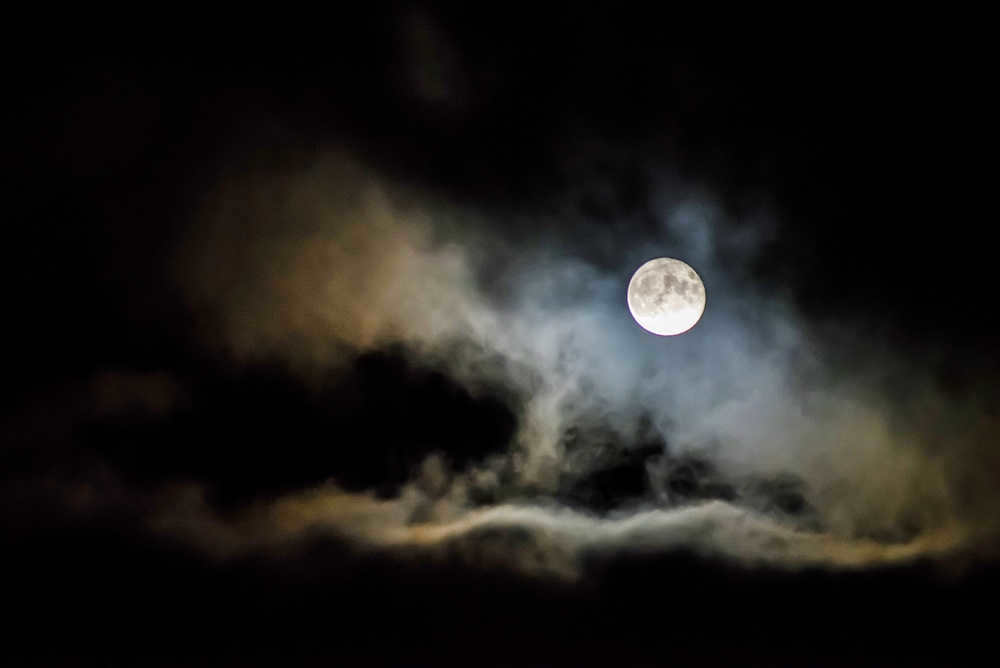

Now let’s delve into the concept of the Moon’s apogee and perigee.
The perigee is the distance between the center of the Earth and the point of closest approach of the Moon. When the perigee coincides with a new or full moon, it is referred to as a supermoon.
On the other hand, the apogee is the farthest point in the Moon’s orbit around the Earth, as well as the orbit of any artificial satellite or celestial body that orbits the Earth.
The opposite point of the perigee is the apogee, as both of these points mark the ends of the apsidal line, which shifts as the position of the apsidal line changes. Therefore, the motion of the Moon’s apogee line is directly influenced by the movement of its perigee. When it comes to the distance of the apogee point, this interval varies based on alterations in the eccentricity of the lunar orbit and the length of its major axis.

We have compiled a collection of resources designed to help you improve various aspects of your life, including relationships, finances, career, health, and purpose.
These resources have been proven effective, with 98% of our students reporting positive changes after implementing them.
Normally, these materials are exclusive to our students, but for a limited time, we are offering them for free. However, please note that they will only be available for a short period before being removed from public access.
- Checklist: “Where to Begin Your Astrology Journey” – Learn how to approach your training in a competent and effective manner.
- Birth Charts and Planets Outline – Discover the characteristics of each planet and their influence on individuals.
- Guide: “The Zodiac Signs” – Explore the classification, associations, and unique qualities of each zodiac sign.
- Guide “House” Event Space and Destiny Sector
- Step-by-step instruction “House Ruler” How the ruler influences the sphere of the house
- Hyde “Major Aspects” The energetic connection between planetary and cuspidal chart readings
- Synthesis” Synthesis of the classical Napoleonic quardatura as an example.
- Guide “Development Plan” You will learn a complete plan for life on the optimal trajectory
The pericenter and apocenter of a celestial body’s orbit refer to the points closest and farthest from the central body, respectively, around which the motion occurs.
The point closest to the central body and farthest from the central body around which the motion occurs is known as the pericenter and apocenter of a celestial body’s orbital point. To determine the specific term, replace the word “center” (after “peri-” or “apo-“) with the name of the central body around which the rotation is planned:
- The Sun, known as Helios, has perihelion and aphelion (apogeolion).
- The Earth, known as Gaia, has perihelion and apogee.
- A star, known as Astron, has periaster and apoaster.
- The Moon has periselepion and aposelepion.
- Venus has periæsperium and apoæsperium.
Phenomena of the Moon’s farthest and closest points in astrology
When the Moon is at its farthest point, people tend to exhibit a heightened sense of optimism and a carefree attitude, seemingly immune to any fears or concerns. For instance, individuals who are driving may completely disregard safety regulations and fail to acknowledge the high speeds at which they are traveling. In terms of emotions, during this period, individuals often find themselves deeply engrossed in various events and relationships, sometimes oblivious to the extent of their involvement.


During this period, the boundaries between what is possible and what is not become blurred. This leads to an increase in the number of unexpected situations and accidents. To navigate through these moments, it is essential to maintain full self-control and closely monitor the development of each situation. If you sense that something is going wrong, it is crucial to quickly regain your composure. It is advisable to avoid consuming stimulants and coffee during this time. Interestingly, when the Moon is at its apogee, the point farthest from the Earth, its influence on individuals is less pronounced.
Aside from the fact that each person has their individual predisposition to this behavior, there are also external factors that can impact it. Furthermore, the Moon is always at a minimum distance of 356.41 thousand kilometers and a maximum distance of 406.7 thousand kilometers from the Earth’s center.
The most challenging situation occurs during the perigee Moon, which is the closest to the Earth. Even the character Othello in Shakespeare’s renowned play expressed the following words while under the influence of the perigee Moon and succumbing to jealousy: “…It’s all the Moon’s fault… Being so close to the Earth, it drives everyone insane…”.
In addition, during the period of the perigee Moon, the Cuban Missile Crisis of 1962 was reaching its apex, posing a significant threat of nuclear conflict. Researchers have discovered that when the Moon is at perigee, it enhances the growth of plants and allows seeds to absorb a greater amount of moisture. This phenomenon is particularly pronounced during the full moon.

Curious about the concept of astrology and its practical applications?
- Interested in gaining a foundational understanding of astrology?
- Eager to explore your strengths and weaknesses?
- Looking for the most modern and effective study methods?
- Fascinated by the skill of interpreting birth charts?
- Master the art of constructing a natal chart
- Comprehend the significance of planets and zodiac signs
- Discover insights on achieving financial success
- Receive a step-by-step guide to advancing in the field of astrology
During these days, it is not advisable to engage in sowing, planting, or transplanting plants. There is a risk of them becoming ill or being infested with pests. Despite following all the proper procedures for planting, the plants will likely not yield any fruits. Additionally, the proximity of the Moon also has a significant impact on human beings.

Individuals with an unstable nervous system find it more challenging. The combination of a new moon, full moon, and eclipse is especially perilous. Based on statistics, during moments when the Moon is at perigee, the number of divorces and even suicides increases.
Consequently, it is advisable to shield ourselves from arguments, relationship clarifications, self-judgment, and judgment of others. Let us remain calm, find joy in each day, and appreciate everything we possess.
2021 Moon’s Apogee and Perigee Periods Table
January 9, 2021 15:40 – Apogee: 367,389 km
January 21, 2021 13:12 – Perigee: 404,360 km
February 3, 2021 19:34 – Apogee: 370,126 km
February 18, 2021 10:23 – Perigee: 404,465 km
March 18, 2021 5:05 – Perigee: 405,252 km
March 30, 2021 6:13 – Apogee: 360,310 km
April 14, 2021 17:48 – Perigee: 406,119 km
April 27, 2021 15:25 – Apogee: 357,378 km
May 11, 2021 21:55 – Perigee: 406,511 km
May 26, 2021 1:53 – Apogee: 357,309 km
June 23, 2021 9:59 – Apogee: 359,959 km
July 5, 2021 14:49 – Perigee: 405,341 km
July 21, 2021 10:31 – Apogee: 364,519 km
August 17, 2021 9:25 – Apogee: 369,126 km
August 30, 2021 2:23 – Perigee: 404,098 km
September 11, 2021 10:07 – Apogee: 368,463 km
September 26, 2021 21:45 – Perigee: 404,639 km
October 8, 2021 17:29 – Apogee: 363,387 km
October 24, 2021 15:31 – Perigee: 405,614 km
November 5, 2021 22:24 – Apogee: 358,844 km
November 21, 2021 2:15 – Perigee: 406,275 km
December 4, 2021 10:02 – Apogee: 356,793 km
December 18, 2021 2:18 – Perigee: 406,321 km
Practical recommendations for the Moon’s apogee and perigee periods
During the period of the Moon’s apogee, significant and consequential incidents have the potential to take place. The psychological and emotional state of individuals can be affected. People may engage in impulsive actions, lose their ability to feel fear or exercise caution, and experience a decline in self-control and attentiveness. Optimism and fearlessness may become excessively pronounced. It is important to note that some individuals may be susceptible to falling victim to fraudulent schemes and manipulative individuals, thereby being enticed into risky ventures.
On the other hand, events have the potential to bring both positive and negative outcomes. Presently, the Moon bestows rewards upon individuals who choose the correct path. This signifies that a person is engaging in righteous behavior and performing good deeds. Conversely, if a person experiences misfortune, a catastrophe, or finds themselves in a critical situation, it indicates that they have veered off course and made numerous mistakes. In such instances, it becomes imperative to reassess one’s life position and contemplate the chosen path. During the Moon’s apogee, everyone receives their just deserts, whether it be a reward or retribution.

It is advisable to spend these days in the company of close companions or family. Strengthen relationships with colleagues and neighbors.
Astrologers suggest that “gaining a higher perspective allows for greater clarity”. During these periods, you can reflect on your life from a higher vantage point and contemplate your actions and lifestyle choices.
Exercise caution while driving, be vigilant around strangers, and refrain from making significant decisions. Take the time to carefully consider important matters. It is best to avoid making promises unless you are completely certain. Otherwise, there may be negative consequences. It is also recommended to steer clear of stimulants, tranquilizers, alcohol, and coffee.
The perigee moon complicates things significantly. While apogee brings maximum optimism, perigee tends to make a person overly pessimistic. All the negative thoughts that have been tightly stored in one’s subconscious start to emerge, clouding their common sense. This leads to the expression of accumulated dissatisfaction towards oneself, their partner, and colleagues. Consequently, conflicts, quarrels, and breakups may ensue. Fears that have been hidden for so long manifest as irritability, moodiness, and can even lead to suicidal thoughts.
However, there is a way to overcome this. Affirmations can be used to create positive thoughts and images, expressing gratitude towards everything that surrounds us, and listening to meditation music. It is crucial to distract oneself from negative thoughts, self-indulgence, and depression as much as possible.


During these days, it is not advisable to:
- operate vehicles;
- prepare financial statements;
- take exams, quizzes, tests (especially in technical fields);
- travel on unfamiliar routes;
- engage in sowing, planting, or rooting plants.
It is important to note that the moon affects vulnerable areas during different stages of its cycle. By using the lunar calendar, you can maximize the benefits of the Moon’s perigee and apogee periods.
The Moon orbits the Earth in an elongated elliptical path, completing one revolution every month. As a result, it comes closer to our planet once a month, reaching the perigee point, and then moves away from Earth, reaching the apogee point.
The term “perigee” is derived from the Greek words “peri” meaning around, about, near, and “Gaea” meaning Earth. It refers to the point in the Moon’s orbit where the distance between the Moon and Earth is at its minimum. The Moon’s perigee ranges between 356,400 and 370,400 kilometers.
The term “apogee” is derived from the Greek words από “apo” – meaning “of, from”, and Gaea Γαία – meaning “Earth”. It refers to the point in the Moon’s orbit where the distance between the Moon and Earth is maximized. The apogee of the Moon is between 404,000 and 406,700 kilometers. The calendar provided is specifically for the city of Moscow.
Select a year:
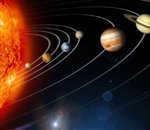
Planetary Proximity and Distance from Earth
Accurate calculations of the closest and farthest distances between Earth and all the planets in our solar system. Explore the data below.

Today’s Sunrise and Sunset
Choose a date on the calendar to discover the exact times for the sunrise and sunset, as well as information about the celestial bodies’ movements. Get ready to be amazed!
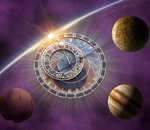
Today’s Planetary Day and Hour
The planetary day and hour today are determined according to the ancient Chaldean astrological order of the planets.
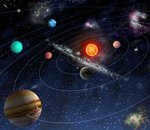
Current planetary positions
This astrology service enables you to calculate the current positions of the celestial bodies in our solar system. Visit
Operating hours: 10:00 AM to 9:00 PM,
Closed on Tuesdays
“Retro Café”: open from 10:00 AM to 8:00 PM during Planetarium working days.
+7 (495) 221-76-90
Planetarium JSC © 2017. Moscow, Sadovaya-Kudrinskaya str. 5, bldg. 1
About the Super Full Moons in 2023
– Can you share some information about the phenomenon of the super moon? – Could you provide an update on the current super moon? – Have you observed the Moon in the evening? What can you tell us about it? – The inquiries keep coming…
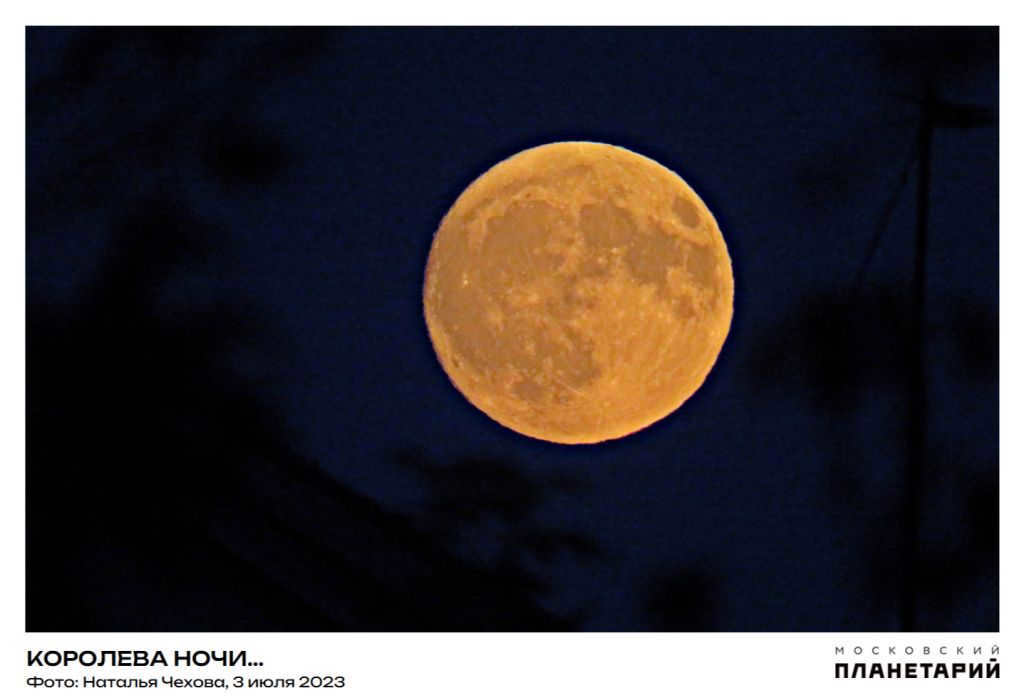

The complete July Moon, as it ascends in the evening, once again captivates the gaze of celestial enthusiasts and compels astronomers to elucidate on its somewhat unconventional full moon! So, it’s about time we delve into the Moon and its “antics”: whether it appears full or half-full in the sky, takes on a crescent shape, or becomes completely elusive, suddenly drawing closer or receding farther from Earth… what exactly is happening with the Moon? How do astronomers rationalize a super moon?
What causes the Moon to appear larger on the horizon?
The Moon’s apparent size is affected by the “moon illusion” phenomenon.
However, when the Moon’s disk is closer to the horizon, it can appear significantly larger than when it is higher in the sky, near the zenith. This phenomenon is known as the “moon illusion” and is actually an optical trick. In reality, the Moon’s actual size does not change based on its position in the sky. This can be confirmed by comparing photographs of the Moon’s disks at the horizon and near the zenith.
Super Moon – an extraordinary full moon
Astronomers have not coined the term “super moon”; it was created by astrologers and popularized by journalists. However, the concept of a super moon, referring to a particularly large and bright full moon, has gained widespread recognition and enthusiasm. When we observe a massive full moon, especially when it appears near the horizon, it is commonly referred to as a “super moon”.
The increased interest in super moons, fueled by media coverage, has prompted astronomers to define specific criteria for this phenomenon:
A super moon is the period when the full moon aligns with the Moon’s closest proximity to Earth (perigee). This alignment occurs for up to three days, and the maximum distance between the Moon and Earth is less than 362,000 kilometers.
Further details about super moons can be found below.
The Moon’s orbit
The Moon travels around the Earth in a path that is not perfectly circular, but rather in an elliptical orbit. It completes one full revolution in approximately 29.5 days, which is known as a lunar month. During this time, there are certain points in the Moon’s orbit where it is closest to the Earth, called perigee, and other points where it is farthest away, called apogee. The distance between the Earth and the Moon can vary from a minimum of 356,410 kilometers to a maximum of 406,700 kilometers, due to the elliptical shape of the orbit. On average, the distance from the Earth to the Moon is approximately 384,400 kilometers. The closest the Moon ever gets to the Earth is less than 362,000 kilometers.
Throughout the course of the year, the Moon experiences monthly fluctuations in its proximity to and distance from the Earth, occurring a total of 12 times. Astronomers have determined the specific month when the Moon reaches its closest point to Earth. In the year 2023, this phenomenon took place on January 21, 2023 at 23:59msk, with the Moon being at its perigee at a distance of 356,569 km.
Phases of the Moon
The Moon is illuminated by the Sun and as observed from Earth, its appearance changes over the span of a month, showcasing various lunar phases such as the new moon, first quarter, full moon, and last quarter.
Now, it is important to direct your attention!
We are particularly interested in two specific occurrences – the full moon and the Moon’s closest approach to Earth (perigee).
Throughout the year, these two events can occur in close proximity to each other, separated by just a few hours or days. These two events “coincide” and during this specific period, the Full Moon gains attention due to its impressive size and brilliance!
During this time, the Full Moon appears 14% larger and 30% brighter compared to the Full Moon at its farthest point, known as its apogee. However, this difference can only be observed when comparing lunar disks in photographs and cannot be discerned with the naked eye.
Therefore, a super moon is essentially a full moon that occurs near perigee, where the full moon approaches the Earth at a distance closer than 362,000 kilometers (perigee) and the moments after perigee and full moon are no more than three days apart.
Supermoons happen annually, but it is rare for the perigee and full moon to coincide closely.
In 2023, there are 4 dates that meet this criteria, as shown in the table:
date and time (Moscow time) distance (Earth-Moon)
The Moon completes one revolution around the Earth every month, following an elongated elliptical orbit. This means that once a month, it comes closer to our planet and reaches the perigee point. Conversely, once a month, it moves away from the Earth and passes the apogee point.
The term “perigee” is derived from the Greek words “peri” meaning around, about, near, and “Gaea” meaning Earth. It signifies the point in the Moon’s orbit where its distance from Earth is at a minimum. The Moon’s perigee ranges between 356,400 and 370,400 kilometers.
The concept of “apogee” is derived from the Greek words από “apo” – meaning “of, from,” and Gaea Γαία – referring to Earth, indicating that at this particular point in the Moon’s orbit, the distance between the Moon and Earth is at its maximum. The Moon’s apogee ranges from 404,000 to 406,700 kilometers. This calendar is specifically designed for the city of Tyumen.
Select a year:


Planetary Proximity and Distance from Earth
Calculated information regarding the closest and furthest proximity of all planets to the Earth’s orbit. Proceed

Today’s Sunrise ☉ Sunset
Pick the date you want on the calendar and discover details about the Sun and other planets rising and setting. Go ahead

Today’s Planetary Day and Hour
The current planetary day and hour are determined based on the ancient Chaldean astrological order of the planets. Proceed

Current planetary positions
This astrology service enables you to calculate the current positions of the planets within the solar system. Leap
Practical suggestions for periods of lunar apogee and perigee
The path of the Moon takes the form of an ellipse. The point at which the Moon comes closest to the Earth is known as the Moon’s “perigee”. When the Moon reaches its maximum distance from our planet, this phenomenon is referred to as “apogee”.
Article contents:
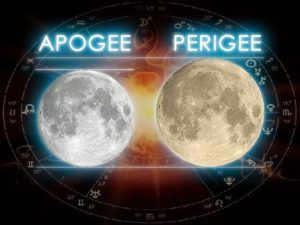
Recommended
Apogee moon
The events occurring on the moon during apogee have a fateful and karmic nature. On the psycho-emotional level, this period is characterized by recklessness, fearlessness, a loss of control, decreased attentiveness, prudence, and vigilance. There is excessive optimism, where one may act blindly and without caution. During the apogee period, people often fall victim to scams, fraudsters, or become involved in risky adventures.
However, there is still room for events to unfold in a positive manner. These fortunate cases are seen as a sign that an individual is moving in the right direction, making wise and correct decisions. In turn, the Moon rewards this person for their righteous life. On the other hand, crises and troubles highlight mistakes and the incorrectness of the chosen path. Catastrophes and unfortunate events serve as signals for reevaluating one’s life position. When the Moon is at its apogee, it is a period of just rewards or retribution.
It is advisable to dedicate these days to spending time with family and loved ones, as well as fostering relationships with partners, friends, and neighbors.
Astrologers often advise: “You can see things more clearly from a higher perspective.” During this period, it is possible to view one’s life path as if observing from an outside perspective, gaining insight into one’s words, actions, and lifestyle choices.
It is important to exercise caution while driving, remain alert when interacting with unfamiliar individuals, and put off making important decisions for a couple of days. Making unachievable commitments is likely to result in seeking assistance from superiors or higher authorities. It is advisable to avoid taking tranquilizers, alcohol, and even strong coffee.
Perigee Moon
The perigee moon, in contrast, is a much more complex phenomenon. While the apogee moon brings about optimism, the perigee moon, on the other hand, tends to induce excessive pessimism. It is during this time of maximum proximity between the moon and our planet that all dark subconscious processes become activated. This is a period when negative thoughts and emotions can cloud the mind, leading to dissatisfaction with oneself and others, and often resulting in arguments, breakups, and the breakdown of relationships. It is not uncommon for hidden fears to manifest, leading to feelings of mistrust, irritability, and even suicidal thoughts, as statistics have shown.
In order to find solace during these periods, one can turn to affirmations, creating positive mental images, expressing gratitude, and listening to calming, meditative music. It is important to avoid indulging in melancholic and depressive thoughts and behaviors.





